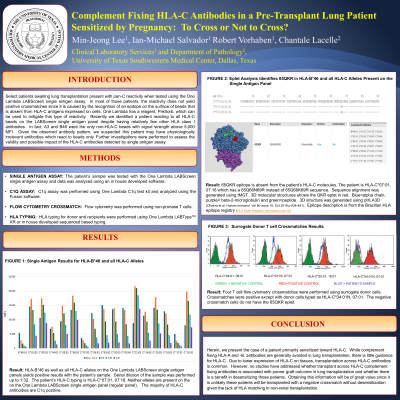Back

Complement Fixing HLA-C Antibodies in a Pre-Transplant Lung Patient Sensitized by Pregnancy: To Cross or Not to Cross?
(P305) Complement fixing HLA-C antibodies in a pre-transplant lung patient sensitized by pregnancy
Location: Platinum Ballroom

Poster Presenter(s)
Body: Some patients awaiting lung transplantation present with pan-C reactivity when tested using the One Lambda LABScreen single antigen assay. In most of those patients, the reactivity does not yield positive crossmatches since it is caused by the recognition of an epitope on the surface of beads that is absent from HLA-C antigens expressed on cells. One Lambda has a reagent, PreSorb, which can be used to mitigate this type of reactivity. Recently we identified a patient reacting to all HLA-C beads on the LABScreen single antigen panel despite having relatively few other HLA class I antibodies. In fact, A3 and B46 were the only non-HLA-C beads with signal strength above 5,000 MFI. Given the observed antibody pattern, we suspected this patient may have physiologically irrelevant antibodies which react to beads only. However, when we performed surrogate donor T cell flow cytometry crossmatches, the only negative crossmatch obtained was with HLA-C*07:01, 04:09N cells. Our patient is HLA-C*07:01, 07:18 while the positive Cw7 beads on the single antigen panel are HLA-C*07:02. When we performed antibody dilutions, all HLA-C beads remained positive at a 1:32 dilution except for Cw7 and C*17. The majority of those antibodies were also positive by the C1q assay. Eplet analysis revealed one shared eplet, 65QKR (65Q66K69R), between HLA-B46 and all HLA-C beads on the single antigen panel. This eplet is absent from the patient’s HLA-C*07:01, 07:18 antigens. It is likely this patient is sensitized to more than one HLA-C eplet but the antibody pattern suggests that 65QKR may be one of the primary target of the patient’s antibodies.
Conclusion: Herein, we present the case of a patient primarily sensitized toward HLA-C. While complement fixing HLA-A and -B antibodies are generally avoided in lung transplantation, there is little guidance for HLA-C. Due to lower expression of HLA-C on tissues, transplantation across HLA-C antibodies is common. However, no studies have addressed whether transplant across HLA-C complement fixing antibodies is associated with poorer graft outcome in lung transplantation and whether there is a benefit in desensitizing those patients. Obtaining this information will be of great value since it is unlikely these patients will be transplanted with a negative crossmatch without desensitization given the lack of HLA matching in lung transplantation.
Conclusion: Herein, we present the case of a patient primarily sensitized toward HLA-C. While complement fixing HLA-A and -B antibodies are generally avoided in lung transplantation, there is little guidance for HLA-C. Due to lower expression of HLA-C on tissues, transplantation across HLA-C antibodies is common. However, no studies have addressed whether transplant across HLA-C complement fixing antibodies is associated with poorer graft outcome in lung transplantation and whether there is a benefit in desensitizing those patients. Obtaining this information will be of great value since it is unlikely these patients will be transplanted with a negative crossmatch without desensitization given the lack of HLA matching in lung transplantation.

